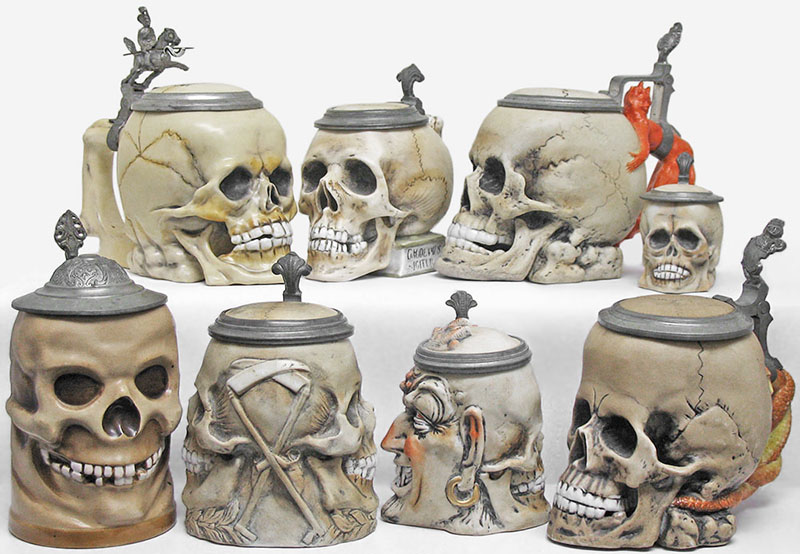
This article is intended as an adjunct to various manufacturer catalogs in the Beer Stein Library. Clicking on any of the links provided herein will produce a separate window displaying the catalog listing associated with the item cited in the text.
—————————
Figural skull steins, many of them eerily realistic, have been collector favorites since they were first introduced in the latter part of the 19th century. The purpose of this article is to set out in some organized form what we know, and don’t know, about the wide variety of antique skull steins (see Figure 1), from both the porcelain production centers in and around the German state of Thuringia (Thüringen) and their stoneware manufacturing counterparts in the Westerwald.
 |
It will probably never be known which manufacturer conceived and produced the first porcelain skull stein. What is certain, however, is that the E. Bohne Söhne factory in Rudolstadt, Thuringia was by far the most prolific and successful of the skull stein makers, producing at least a dozen different varieties. In addition to the steins known to have been made by Bohne, there are also a substantial number of porcelain skull steins that display many of the characteristics of Bohne skulls, some of which are known to have been made elsewhere and others that have not as yet been attributed to a specific manufacturer.
The Skull Steins of E. Bohne Söhne
If availability today is indicative of their popularity 100 years ago, then the porcelain skull steins produced in the Rudolstadt factory of E. Bohne Söhne, were clearly among the most popular figural steins of their time. While it is possible in many cases to count on the fingers of one hand the number of surviving examples of other known Bohne figural stein offerings, Bohne skull steins seem to appear in almost every beer stein auction, and are as popular with collectors today as they were with German students and others in the late 19th and early 20th centuries.
Skull on Book — Perhaps the most well-known and often seen of the Bohne skull steins is the “skull on book”. As its name indicates, the skull portion of the stein sits on a Commersbuch (drinking session song book) on which are written the words “Gaudeamus igitur, juvenes dum sumus,” recalling a German university student song dating back to the 13th century which advises the students to rejoice while they are young, because in the end the earth will cover their bones. As may be seen in the Bohne Stein Catalog listing, this stein was manufactured in three different sizes: 0.5-liter, No. 9136, as well as 0.4-liter and 0.3-liter counterparts, numbered 9136/4 and 9136/3 respectively. At least one 0.6-liter version and a larger number of 0.25-liter versions of this stein have also been seen. However, these have been shown to be merely the 0.5-liter and 0.3-liter steins, respectively, with the fill lines moved up or down as necessary.
The 0.5-liter skull on book stein was also made with a music box base which required an expansion of the “book” to about double its normal width. The originally installed music box played Gaudeamus Igitur, a song later popularized in the U.S. by the 1924 Broadway production of “The Student Prince,” and which is still widely performed today.
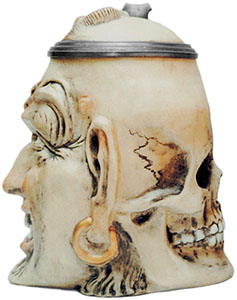 |
Devil/Skull Combination — A third type of Bohne skull stein combined a skull face with the face of the devil in a back-to-back arrangement. Here again, the stein was made in two sizes, the first with a 0.4-liter capacity numbered No. 5940, and the second a 0.2-liter version, No. 5940/2.
Not unlike the largest skull on book, the 0.4-liter version of the skull/devil stein is known to exist with 0.5-liter capacity markings produced by the simple expedient of moving the fill line from a point about three-quarters of an inch from the top to very near the rim. The stein will actually hold a half-liter, but the raised mark makes no allowance for the foam head that is the natural result of pouring a beer. In at least some cases, Bohne overcame this problem with the addition of an extra ring of porcelain around the top of the 0.4-liter stein (Figure 2). While this contrivance provides sufficient room for the foam, the resulting elongated foreheads (particularly on the skull side) produce a disproportionate appearance that is somewhat less than aesthetically pleasing.
At least one example of the devil/skull stein is also known to exist on a “Commersbuch” base with dimensions similar to those used to produce the music box version of the skull on book stein. Although that example, which is shown in the Bohne Stein Catalog listing, didn’t actually contain a music box, it may be reasonably assumed that it was installed at the outset and has simply been lost over time.
 |
Skull with Entwined Snakes Handle — The last of the known Bohne skull steins, the 0.5-liter No. 695, substitutes a pair of entwined snakes for the “bone” handle found on all other Bohne skulls. The intent here was no doubt to appeal to physicians and medical students by bringing to mind the similarly configured “caduceus“ (Figure 3), which began taking root as a symbol of the medical profession in the late 19th century.
In yet another attempt to expand the capacity of a stein that just barely manages to handle its stated half-liter capacity, this stein can also be found with the upper portion elongated, again creating a disproportionate forehead that in this case may be seen in the example shown in the lower right-hand corner of Figure 1.
Porcelain Skulls Attributable to Other Known Manufacturers
 |
Schierholz is known to have made four different skull steins, a 0.4 and 0.5-liter skull on book and two skull steins sans book in comparable sizes, none of which have been seen bearing a visible mold number. In light of the timing of their introduction, the Schierholz skull steins were presumably produced in response to a perceived unmet demand for such items following the Bohne failure. Unfortunately, that assessment seems to have been incorrect. Based on their rarity today, it would appear that Schierholz skull steins failed to attract much consumer attention.
Wilhelm, Münch & Zapf — The porcelain firm of Wilhelm Münch & Zapf (WM&Z) was founded in the late 1890s in Rudolstadt by Wilhelm Münch. Interestingly, the firm was located within blocks of the Bohne factory, from which WM&Z may well have drawn the inspiration for their skull steins. However, the company apparently did not experience a great deal of success, and was sold and renamed in 1905, so production of WM&Z skulls was relatively short-lived, no doubt accounting for their relative rarity today.
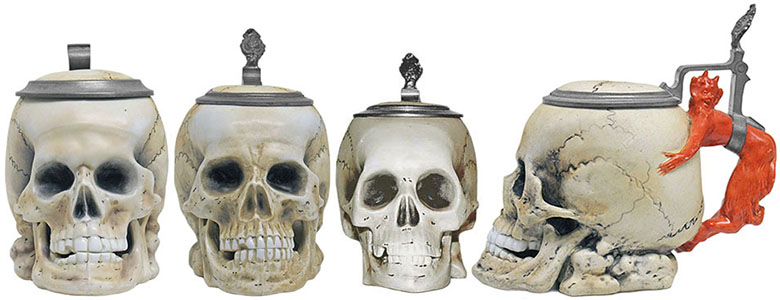 |
 |
WM&Z No. 1746 (Figure 5, left) is also a 0.5-liter stein and has the same body as No. 1876, but with a more typical “bone” handle. WM&Z 1338 (0.4-liter) and 1747 (0.3-liter), are configured much like No. 1746, with all three exhibiting a number of easily observable common characteristics.
With regard to pricing, although WM&Z skull steins are significantly more difficult to find than those produced by fellow Rudolstadt porcelain maker Ernst Bohne Söhne, WM&Z skulls are typically sold for prices that are largely comparable to those achieved for their Bohne counterparts. In fact, it’s fair to say that there is currently little apparent relationship in general between sale prices for porcelain skull steins and their relative rarity.
Porcelain Skull Steins of Undetermined Origin
As we have already seen from the previous examples, many early porcelain skull steins have multiple shared characteristics that make it difficult, and sometimes impossible, to determine the maker absent some kind of logo or other manufacturer’s mark. In some cases, even though a particular skull stein displays almost all the characteristics of a certain manufacturer, the evidence has so far been insufficient to make a conclusive judgment.
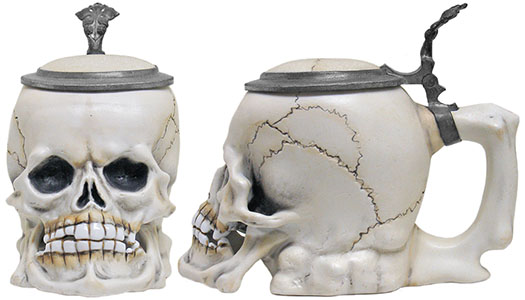 |
Most Bohne steins used the handle in a manner designed to stabilize the stein by extending it down flush with the bottom of the stein. The stabilizing handle wasn’t exactly a characteristic unique to Bohne, but it is one that is generally associated with Bohne steins. For example, compare the handle configuration of Bohne No. 8423 with that of the wide-jawed skull in Figure 7. On the other hand, while the two handles are clearly conceptually similar, the two implementations of the concept would not appear to be otherwise related.
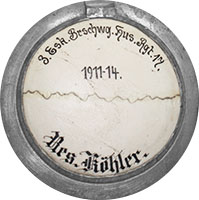 |
Wide-jawed skulls are known to exist in three different sizes — 0.5, 0.4 and 0.3-liter — all identically configured and largely indistinguishable from each other except for capacity. However, it should be noted that the 0.5-liter size is sometimes seen bearing the markings and fittings of the 17th Hussar (light cavalry) regiment in Braunschweig, which adopted the skull as its de facto symbol, and the wide-jawed skull stein as a quasi-official souvenir of regimental service, perhaps at least in part due to the particularly fierce, almost growling look of the jaw/teeth configuration. An example of a 17th Hussars wide-jawed skull stein may be seen in Figure 1 (top left), the conversion being accomplished with the simple addition of a mounted lancer thumblift and some hand-inked calligraphy, which is generally found on (and sometimes under) the lid and typically lists, at a minimum, the owner’s name, unit and dates of service (Figure 8).
While pricing for wide-jawed skulls is generally in line with that of other porcelain skull steins, when configured as a 17th Hussars regimental, the same half-liter stein typically sells for five or six times the price of its unadorned counterpart.
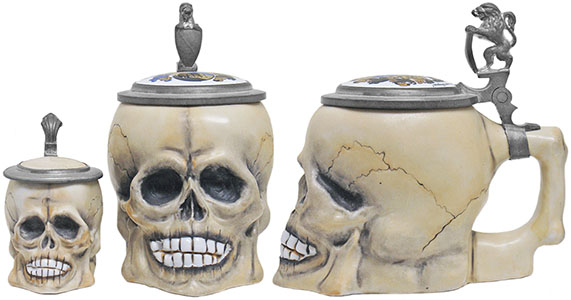 |
So far at least, the grinning skull design has been seen in only two sizes, 0.4-liter and a 1/16-liter miniature that stands only 2½ inches tall. The miniature is just about the right size for a liqueur serving, but more than likely it was intended simply as a curio cabinet display item. However, despite its diminutive size, the miniature typically sells at auction in a price range comparable to its half-liter counterparts.
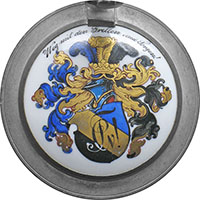 |
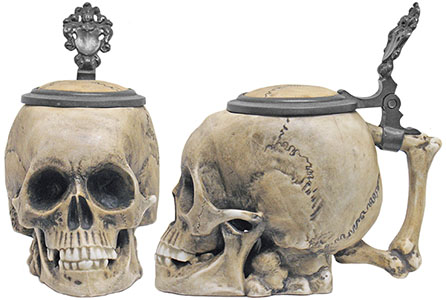 |
And finally... — The last of our unattributed porcelain skull steins (Figure 11) bears much in common with the 0.3-liter Wilhelm Münch & Zapf stein discussed earlier (see Figure 5, middle right), including a similar, though not identical “bone” handle, and a four-digit number (i.e., 1358) inscribed on the rear of the base. It’s about the same size as WM&Z No. 1747, but unlike all other confirmed WM&Z steins, it has no visible capacity mark. This stein also has a bisque finish while the WM&Z steins tend more toward semi-gloss or “satin,” and a somewhat rougher overall look and feel which doesn’t match up particularly well with WM&Z either, not to mention a variety of differences in facial details.
At the bottom line, it’s certainly possible that this stein is in fact a product of the Wilhelm Münch & Zapf factory, but given the low probability that WM&Z would make two similarly sized skulls with only minor differences in design and execution, it seems far more likely that this is simply a copycat piece from another porcelain factory.
Stoneware Skull Steins
Surprisingly, Westerwald stoneware stein manufacturers appear to have had little interest in competing in the skull stein market with the German porcelain factories to their east. Only three Westerwald firms produced skull steins prior to World War II, and none more than a single model.
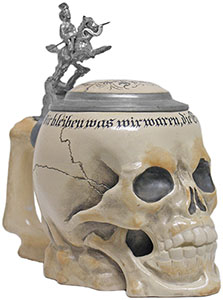 |
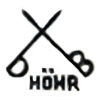 |
Dümler & Breiden No. 852 was first produced circa 1908, and appeared for only a short period in regimental trim, but the unadorned version of the stein continued to be manufactured for some time thereafter, as attested to by the fact that examples have been seen bearing the mark shown in Figure 13, first used in the 1930s.
Marzi & Remy — The firm of Marzi & Remy also began producing a 0.5-liter skull stein during the first decade of the 20th century, but as is quickly apparent from the images in the catalog listing, M&R No. 1796 is a far cry from the steins we’ve looked at up to this point in our discussion. The M&R skull was available in at least three colors, ranging from a bonelike beige to a clearly non-bonelike reddish brown. Seeming to almost smile back at the viewer, the stein also fell well short of “realistic” in most other aspects of its appearance. Since the craftsmen at Marzi & Remy were no doubt capable of producing a more lifelike skull, one would have to conclude that there was no intent to compete directly with the skulls from D&B or any of the porcelain makers. Rather it would seem that the M&R skull was meant to appeal to an audience that might not be all that comfortable with a stein that brought to mind the kind of morbid thoughts evoked by its more realistic competitors. The regular appearance of M&anp;R skull steins on the auction block today would appear to indicate that the approach was successful, and that there was no shortage of early 20th century buyers for this softer rendering of an otherwise potentially disconcerting image.
Reinhold Hanke — First produced at about the same time as the other two Westerwald skull steins, the 0.5-liter Hanke No. 1423 exhibits the same “user-friendly” approach adopted by Marzi & Remy. If anything, Hanke takes the concept a step further with the gapped-tooth grin and a pewter lid that can’t help but bring to mind a little sun hat. The Hanke skull is also seen with some degree of regularity in the contemporary marketplace, so apparently it too was able to find a fairly receptive audience in its day.
A Final Thought
This discussion has presented what I believe to be the current state of the art with respect to antique skull steins (ca. 1890-1935). However, I don’t doubt for a minute that there are additional designs out there that have not yet crossed my radar screen, and almost certainly examples of steins that I’ve mentioned with identifying marks that would answer some of the open questions.
One of the advantages of publishing online is that as new discoveries are made they can be immediately integrated into existing research material. So if after taking a look at any skull steins in your own collection, you can add new information to what you’ve just read, please contact me through the Beer Stein Library at [email protected]. Any new information received will be incorporated into this article to be shared by all interested collectors and, of course, credit will given in “What’s New” to the contributor.
__________
*Portions of this article appeared previously in the September 1999 issue of Prosit, the Journal of Stein Collectors International.
© 2012 Beer Stein Library — All rights reserved.